New multi-purpose frigates "Mogami" for the Japan Self-Defense Forces
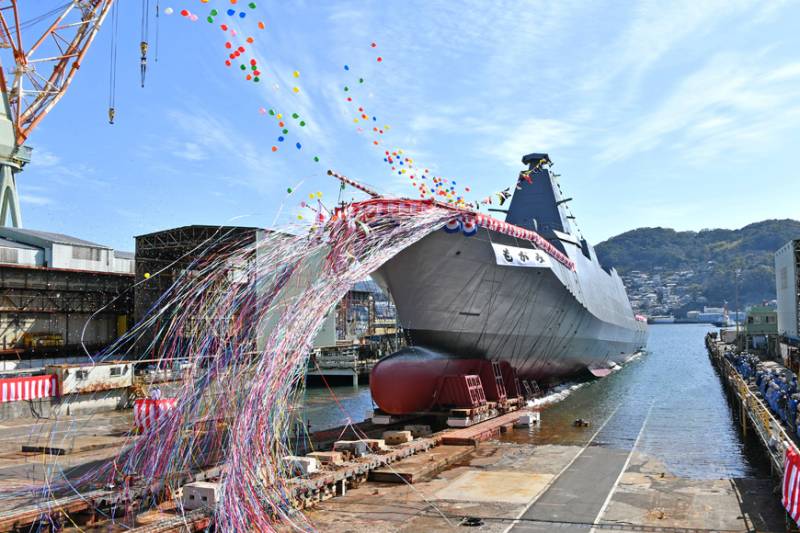
Launching of the lead frigate "Mogami", March 3, 2021
A few years ago, the Japanese industry began building promising multi-purpose frigates of the Mogami type. According to existing plans, in the distant future, the Maritime Self-Defense Forces will receive more than two dozen such ships. Such a large series will make it possible to replace the frigates and destroyers of three different types currently in service.
Project development
In 2015, the Maritime Self-Defense Forces (MSS) launched a program to create a promising multi-purpose frigate “in a compact body”. With the help of such ships in the distant future, it was proposed to replace the existing frigates of the Abukuma project, which were built in the eighties and nineties. Several large shipbuilding organizations were involved in the program.
Mitsubishi Heavy Industries became one of the program participants. She offered MSS her own project of the frigate 30FF, previously developed on her own initiative. Such a project as a whole suited the customer, and it was accepted for further development. As studies and assessments were carried out, the requirements for the future frigate gradually changed, and the project was reworked along with them.
In 2016-17 MHI has developed and introduced a deeply revised version of the 30FF frigate under the designation 30DX. It differed from the original project by reducing the main technical risks and a number of innovations. So, they rebuilt the hull, changed the composition of weapons and added an anti-submarine function. Due to all this, it was possible to provide advantages over the base 30FF and reach a different level of performance.
As a result, the MSS began to consider the new ship as a replacement for both the Abukuma frigates and the larger Asagiri and Murasame-class destroyers. Accordingly, the planned series has grown - from 5-6 units. up to 22.
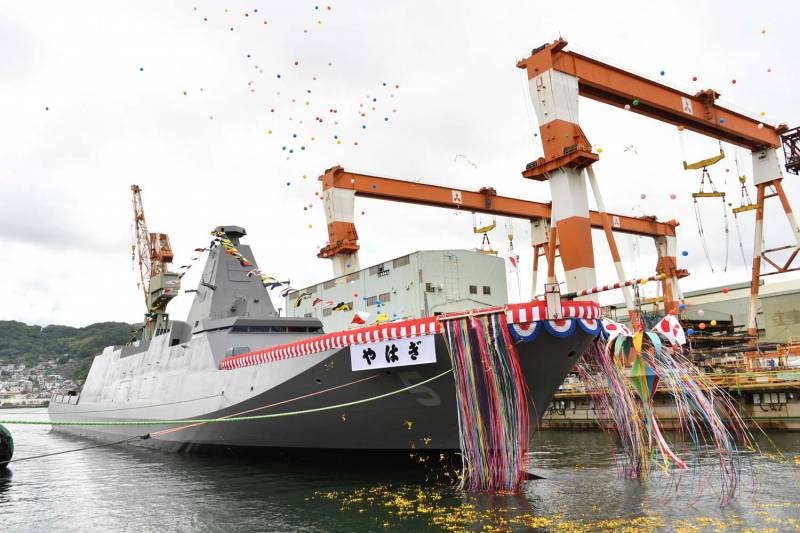
Yahagi (FFM-5) launched, June 23, 2022
All innovations influenced the range of ships in an interesting way. So, in the MSS of Japan, frigates receive a tactical number with the letters "FF". Especially for the ships of the new project, the FFM prefix was introduced, indicating the expansion of combat capabilities. The numbering of the new "class" is from one. The project also received the name "Mogami" - like the lead ship. The first frigate and the entire series were named after the heavy cruisers of the Imperial fleet.
Construction contracts
In August 2017, the Ministry of Defense of Japan issued the first contracts for the construction of promising frigates. The work was carried out by MHI and Mitsui Engineering and Shipbuilding. The construction was to be carried out by their factories in Nagasaki and Tamano, respectively. It is curious that Mitsubishi recently acquired the Mitsui plant in Tamano, and now actually conducts all the construction.
Under a 2017 contract, the two companies are to build eight Mogami-class frigates. The first ships were planned to be laid down in the near future, and they were going to be accepted into the MSS in 2022. In the future, the laying, launching and commissioning were to become regular. The entire series should enter the MCC in 2022-25.
The total value of the contract reached 400 billion yen or 3 billion US dollars - 50 billion yen or 390 million dollars for each ship. The equivalent of the price of two ships will be allocated annually for the construction.
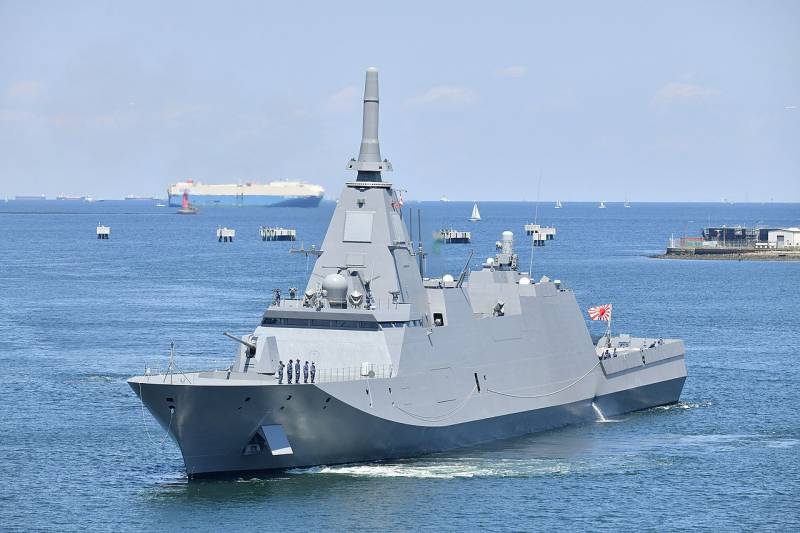
"Mogami" (FFM-1) at sea
In 2020, information about the first foreign order appeared. The frigate "Mogami" became interested in the Indonesian Navy. Then agreements were signed, according to which Japan would sell four ships of its own construction. Four more buildings will be built in Indonesia with Japanese help.
Ships in service
On October 29, 2019, at the Mitsubishi plant in Nagasaki, the laying ceremony of the lead frigate of a new type, the Mogami (FFM-1), was held. The next day, MSS and the Mitsui company laid down a second ship called the Kumano (FFM-2). For various reasons, Mitsui completed the work faster. The shipyard in Tamano launched its frigate on November 19, 2020, while the ship of the same type in Nagasaki was sent for completion at the wall only at the beginning of March 2021.
The second frigate of the series quickly passed the necessary tests, and on March 22, 2022, it was accepted into the combat structure of the Navy. The flag-raising ceremony on the lead Mogami took place on 28 April. To date, two ships have begun full-fledged service, go to sea and participate in the general activities of the fleet.
On July 15, 2020, two ships were laid down at the MHI plant at once - Noshiro (FFM-3) and Mikuma (FFM-4). They were launched in July and December 2021, respectively. Both frigates have already been completed and are undergoing the necessary tests at the pier and at sea. It is assumed that the MSS will receive the Noshiro by the end of this year, and the next ship will begin service in March.
Two more hulls were laid down at the MHI plant on June 24, 2021. On June 23 of this year, the first of them, named Yahagi (FFM-5), was launched. The remaining construction and testing will continue for another year; delivery is scheduled for the end of 2023. In the coming weeks, it is planned to launch the FFM-6 frigate, whose name is still unknown. His MMS will be received in March 2024.
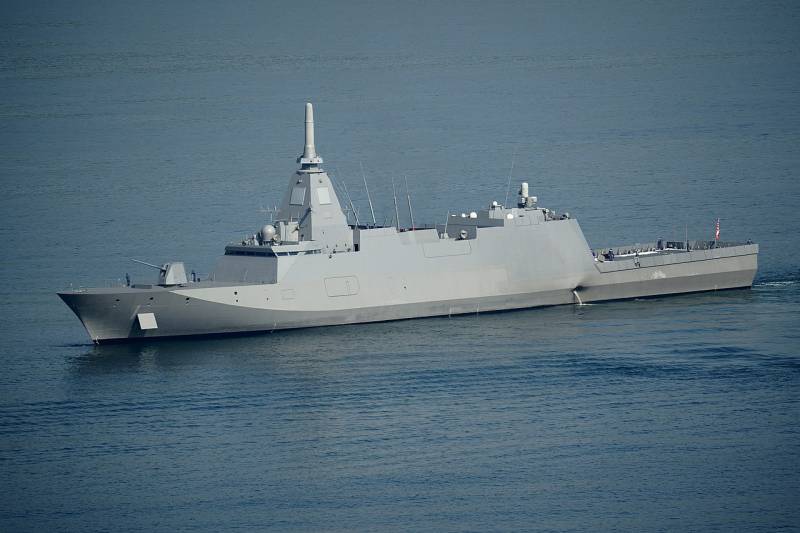
This year only one ship was laid down, already the seventh in the series. The corresponding ceremony took place in Nagasaki on June 30. An exact date for the completion of construction has not yet been announced. Judging by the available data, the FFM-7 will be launched no earlier than next summer, and it will enter the combat fleet only by the end of 2024.
Plans for the future
Under the 2017 contract, the first two ships were built and commissioned, and the third is being tested and will soon begin service. Four more are in various stages of construction. The eighth and last frigate has not yet been laid down. It is likely that its construction will begin next year, and the transfer to the fleet is scheduled for 2025. According to known data, it will be built at the former Mitsui plant.
The program for the construction of multi-purpose frigates will not end there. MSS Japan is planning a major upgrade of the surface fleet, and they need 22 of these ships. Accordingly, 14 more buildings are to be contracted. The next construction order will be issued no later than 2025. How many ships and at what price will be included in this contract is not yet known.
In the period after 2025, it is planned to maintain the achieved production rates. Two ships will be laid down annually; in parallel with this, the two previous frigates will be launched. Accordingly, the customer will receive a pair of pennants every year. The fleet will receive the last of the 22 required ships in 2032.
As the service of the new Mogami begins, the MSS of Japan will write off the old ships. The first to replace eight Asagiri-class destroyers built in 1986-89. Then six Abukuma frigates will retire from service. Nine Murasame destroyers were commissioned by the Navy between 1996 and 2002 and will be the last to be replaced.
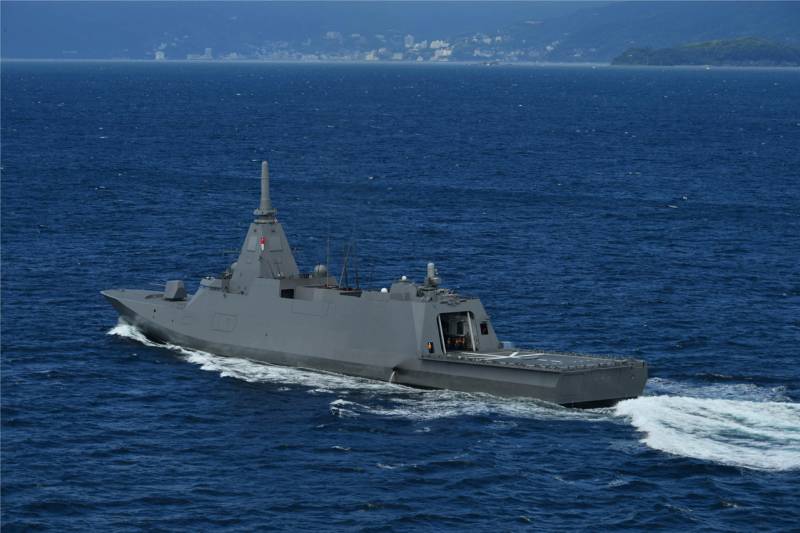
Technical features
Project 30DX / FFM / "Mogami" proposes the construction of a surface ship with a length of 130 m and a width of approx. 16 m with a standard displacement of 3,9 thousand tons and a full displacement of 5,5 thousand tons. Crew - approx. 90 people
The frigate was designed using stealth technology, which is why it has a “inconspicuous” shape characteristic of modern ships. A wide superstructure with flat sides is placed on the body of standard contours. Radio-electronic equipment is mounted on a mast-pyramid. There is a heliport in the stern.
The ship's power plant includes two MAN V28 / 33DD diesel engines with a power of 9760 hp each. and one gas turbine Rolls-Royce MT30 with a capacity of more than 53 thousand hp. The CODAG scheme is used: diesel engines are the main ones, and if necessary, a gas turbine engine is connected to them. The maximum speed of the ship exceeds 30 knots.
The project provides for the use of a multi-purpose radar with AFAR type OPY-2 and a number of other radar facilities. There is a NOLQ-3E electronic intelligence complex, an OAX-3 optoelectronic station, hydroacoustic complexes with a built-in and towed antenna, etc. All means are united by the information and control system OYQ-1.
The ability of the frigate to solve various combat missions is determined by the presence of barrel, missile and mine-torpedo weapons. So, a 127-mm Mk 45 artillery mount is mounted on the nose in front of the superstructure, and machine-gun combat modules with remote control are placed on the sides.
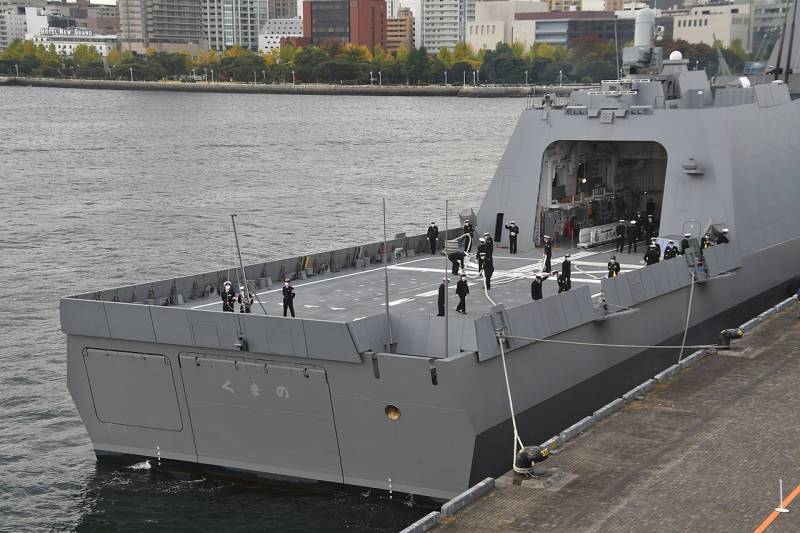
The stern of the ship "Kumano" (FFM-2). The landing pad, hangar and SeaRAM air defense system on the roof of the hangar are visible
Two launchers for Type 17 anti-ship missiles are placed in the center of the superstructure. The total ammunition load includes 8 such products. Launch range - up to 400 km. There is a vertical launcher Mk 41 with 16 cells for different types of missiles. Her main weapons are anti-aircraft missiles "Type 03" with a launch range of 50 km. For defense in the near zone, there is a SeaRAM complex with a RIM-116 missile.
To combat underwater targets, an anti-submarine missile "Type 07" is proposed with a launch from the Mk 41 installation. Torpedo tubes of 324 mm caliber are installed in the side ports. They must use Type 12 torpedoes or similar weapons.
The aft landing pad and hangar in the superstructure are designed for the H-60L helicopter, a Japanese licensed version of the American UH-60. Also, the introduction of unmanned aerial vehicles is not excluded. aviation complexes.
Quality and speed
Multi-purpose frigates "Mogami" as a whole look like quite modern warships with wide capabilities and fairly high performance. They can be compared with various frigates and destroyers from other countries, and at least the tabular characteristics will be on the same level. Thus, the Japan Maritime Self-Defense Force can expect to obtain all the desired results.
Attention should also be paid to the pace of shipbuilding. About two and a half years passed from the laying of the first two frigates to their commissioning. The third also fits into these terms, and the fourth will spend several months more. All this shows that the Japanese military shipbuilding has the necessary potential and is able to master the rapid and rhythmic production of modern ships, at least in the frigate class.
- Ryabov Kirill
- Japanese Ministry of Defense, Wikimedia Commons
Information